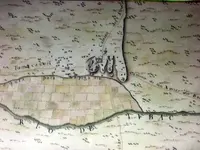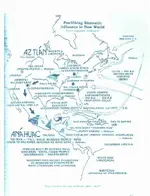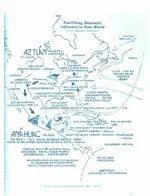Greetings,
This is a very long and somewhat off-topic reply, my apologies and feel free to skip this post if you like. Otherwise I must beg your indulgence, thank you in advance.
I had considered asking our friend RWLJ a few questions, but did not wish to interrupt the discussion between him and Cactusjumper. RWLJ we have met, a little over a year ago, but perhaps you do not remember me. I remember your theory pretty well.
The alternative history as presented is certainly interesting, yet is fraught with problems. Pointing to Egypt as a place that sent armies and fleets (for the armies had to be transported) into the American southwest simply won't work for me. True, Egypt did send out several seaborne expeditions over the centuries, usually to the "mythical" land of Punt, but at least one that ventured into the Atlantic in a mission to circumnavigate Africa, and in that case they simply hired Phoenicians to make the voyage. <
Referring to the expedition sent by pharaoh Necho> Egypt kept fairly good records, and seaborne expeditions were well documented. If an army had been sent across the Atlantic, it is extremely likely that some Egyptian record of the event would be known.
As for the other candidates, from Genghis Khan to the Israelites and many others, there are problems with most of them. There is evidence that some contacts were made across the oceans in ancient times, but of a sporadic, likely accidental and quite insignificant nature. The only documented attempt to plant a colony was withdrawn, (
stated in same source, Aristotle, "On Marvelous Things Heard") and all evidence points to that colony being located on the east coast of the US, certainly not in the southwest. Even so, while there is no description of how large that colony was, there is no reason to think it was a large colony and may well have been a single ship load of colonists. Remember the Plymouth colony was only the Mayflower, so important in history yet with surprisingly small numbers of people and resources involved.
If Solomon and his "navy" were indeed traveling to the American southwest for gold, that expedition likewise could not have been very large in size. His "navy" was of only twelve ships, built at great cost and labor, and each voyage took three years. As the evidence in support of Solomon's fleet coming to America also seems to indicate that they were circumnavigating the globe, three years which did not allow a lot of time for traveling inland; in fact the first two (recorded) circumnavigations of the world took almost exactly three years <
referring to Magellan and Drake>. Perhaps mining camps were established and only visited every three years, however shortly after Solomon's death, his vassal state of Edom where his all-important departure port of Ezion-geber was located, revolted and access was lost. Twice later in history this far reaching trade was attempted by kings of Judea and Israel, but we have no evidence that they were successful. So any mining camps would have been stranded, unless they were able to somehow obtain passage home.
What bugs me in this alternate history is that there ARE a fair number of what we could call 'advanced' civilizations living in America in ancient times, and in scenarios such as RWLJ proposes, we must either ignore them or change their identity to a foreign (Old World) source. The Hohokam, Hopewell, Adena and others built large cities from the east coast into the deserts and from the Gulf coast well into Canada; some had excellent roads, were very good farmers, and traded over a rather vast region. There is evidence of Aztec and even Mayan trade with tribes of the southwest, particularly for the beautiful turquoise so highly valued by them. One look at some of the head-dress styles worn by Moche in Peru will sure suggest that those people had contact with ancient Hebrews or Arabs, and it is quite possible. Some ancient Amerindian cultures remain un-identified, such as the mystery culture that had a string of towns and was farming and quarrying stone in SE Wyoming several thousand years ago.
In fact there is evidence that people were visiting America well back in the Bronze Age, from Minoans to Greeks, followed by Chinese, Celts, Phoenicians, Carthaginians, Romans, Etruscans, Iberians, Arabs, Welsh, Africans, Scots, Irish and Norse all before Columbus. Many of these adventurers never returned home to tell of their visits and in many cases the voyage took on mythical attributes over time. So you see, I am not just a nay-saying skeptic about such theories, but we must stick to what the evidence will support, and the evidence does not support the idea of mass armies of Mizraim sailing across the ocean and campaigning through the American deserts.
But as to how this all relates to RWLJ's theories, well we could as easily point to the Yukon, Mississippi, Amazon, and Orinoco rivers and state those are the four rivers of Eden; we could even point to the authority of Christopher Columbus himself who wrote that the Americas are in fact Eden. It is fun to speculate but simply won't fit. The mines of Tumacacori were mostly silver mines for instance, and to identify that with Havilah of the Old Testament we have to wonder how it is that the Lord bothered to mention the good gold of Havilah, yet ignored the silver? Until the time of king David, the Hebrews were largely a pastoral people with no seagoing abilities whatsoever. By close association with their neighbors the Phoenicians, the united kingdom of David started their relatively short career as a seagoing culture. The map in True Treasure magazine may well be right, but I doubt it; for there are several such maps which show the "true locations" of the various mines associated with Tumacacori, and yet when you go to those places you do not find mines. The maps must then be wrong.
No offence intended RWLJ, you do have a very interesting set of theories, however I remain (respectfully) very un-convinced. It does not help convince the readers when you refuse to name scholarly sources for your statements, and as you say these sources are already published, there is no reason to keep them a secret for the articles or books have already been made public by getting published. Your linking of the lost Dutchman, the mines of Tumacacori, the lost Adams and others are in my opinion very much an over-reach. The way it is coming across, sounds as if there are virtually no gold or silver deposits located outside of your site in all of the southwest, which is very far from fact. You are not the first to propose that several lost mine legends are all one and the same, and there are cases where it very well may be true; as with the Doc Thorne, Lost Dutchman and lost Black Maverick which might be talking of the same mine but
not the Dutchman, Adams and Tumacacori mines which are all quite different. I remember the beautiful gold nuggets you displayed when we met, which very well could have come from the Lost Adams which was a placer gold deposit, and placers produce nuggets, but it would not conform with the quartz lode gold of Waltz much less the silver sulphides and native silver of the Tumacacori mines. If you own the place where those nuggets came from, the rest of the theories are not that important for the gold mine should be profitable. If you have located an "Underworld" with 3000 rooms, it would be wise to contact the authorities in government and show them the sites, so that they may be property protected and become photographed etc for all of us to benefit.
As to Mitchell and the Molina document; all writers are at the mercy of their sources. John D. Mitchell resided in Arivaca for some time, and spent much of his free time searching for many of the lost mines and treasures which he wrote about. That would indicate to me that he at least believed the stories were true. If it is true that he obtained his copy of the Molina document from Milton Rose, we should not point at Mitchell as the fraud. It is only my own opinion but Rose is a very questionable source.
Good luck and good hunting to you all, I hope you find the treasures that you seek - and wishing you all a very Happy Thanksgiving.
Roy ~ Oroblanco














